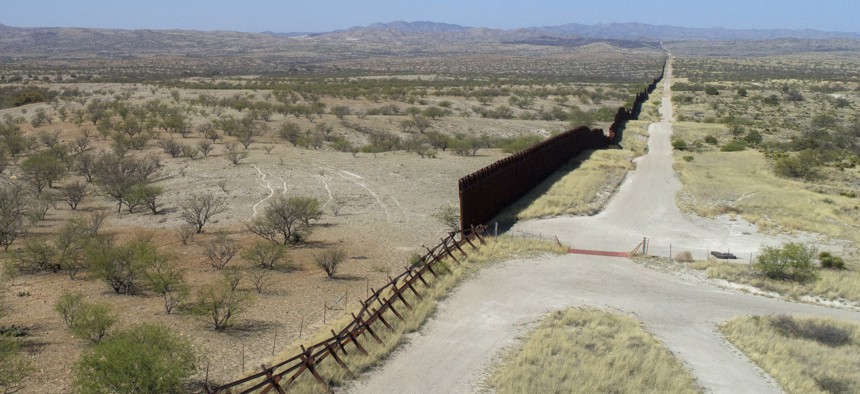
A drone view of the US-Mexico border fence outside Nogales, Arizona, Saturday, April 1, 2017. AP Photo/Brian Skoloff
Border State Lawmakers Propose a 'Smart' Wall
The group wants radar technology, drones and cameras to make up big chunks of Trump’s proposed border wall.
A bipartisan group of lawmakers wants drones and cameras to make up parts of President Donald Trump's proposed U.S.-Mexico border wall rather than a physical barrier.
Rep. Will Hurd, R-Texas, introduced legislation Thursday that would direct the Homeland Security Department to create a smart wall that uses a network of sensors, fiber optics, unmanned vehicles and other products to track activity near the border and keep out drugs and undocumented immigrants. The bill also would require DHS to submit to Congress a detailed plan including cost justifications for technology used at each mile of the border.
A so-called smart wall could help border agents interdict people and contraband, potentially at a lower cost than current levels, and could be "fully operational within a year," Hurd said in a statement. “Violent drug cartels are using more modern technology to breach our border than what we are using to secure it."
The Secure Miles with All Resources and Technology, or SMART Act, is co-sponsored by Reps. Henry Cuellar, D-Texas, David Valadao, R-Calif., Steve Knight, R-Calif., Steve Pearce, R-N.M., Brian Fitzpatrick, R-Penn., and Keith Rothfus, R-Penn. Hurd's district includes more than 800 miles of the U.S.-Mexico border.
The SMART Act would authorize a $110 million set-aside for Customs and Border Protection and the State Department to collaborate on border security. It also would create a two-year grant program dedicated to upgrading communication networks on the border.
"[R]ather than building walls to meet campaign promises, it takes a measured approach by directing DHS, in conjunction with state and local agencies" to analyze the technology that could be used to secure the border, Cuellar said in a statement. "A giant wall is nothing more than a 14th Century solution to a 21st Century problem."
The smart wall vision appears to be in line with DHS officials' own plan for the border. At a House subcommittee hearing earlier this week, U.S. Border Patrol's acting Chief Scott Luck testified that a combination of people, technology and physical barriers would all be essential to a secure border. Physical barriers might be especially helpful in stemming the flow of entrants in urban areas, he said.
An ideal technology system would ensure that "information is shared immediately to all components and agents and officers who need it," Luck said then.



